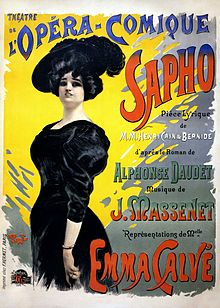Emma Calvé
Emma Calvé (born August 15, 1858 in Decazeville ( Aveyron ), † January 6, 1942 in Montpellier ( Hérault ); actually Rose Emma Calvet ) was a French soprano / mezzo-soprano . The Carmen du siècle - so she was greeted by her enthusiastic contemporaries - is despite their relatively short career as one of the greatest opera singers of the so-called Belle Epoque .
Life
Emma Calvé grew up in a humble family near Roquefort . Her father Justin Calvet worked as a contractor for mines and the Compagnie du Midi railway line . Little Emma spent her first years in Spain; in her home country she was entrusted to various monastery schools, where her voice was soon noticed. After her parents separated, she lived with her mother, Léonie, first on the Causse , then in Paris , where she took singing lessons from private teachers.
When she became famous, she acquired the feudal Cabrières castle near Aguessac north of Millau , the restoration of which cost several million.
In America in 1916 she became a committed ambassador for war-torn France on all stages. Wrapped in a tricolor , she aroused passionate enthusiasm while singing the Marseillaise , which - as was claimed shortly thereafter - caused the United States to enter the war .
During her trip around the world, which was designed like a farewell tour, she married a colleague who was traveling with her, an Italian tenor whose passion for gaming was no secret. Cabrières Castle later became a singing college for young American singers. Always proud of her homeland, even in old age, she sang the folk songs of her region in Occitan at the celebrations in Millau and Arles .
At the end of her life, she lived in a simple, middle-class house in Millau's city center. On January 6, 1942 Emma Calvé died lonely and withdrawn at the age of 83 in a clinic in Montpellier . Three days before her death, a reporter from the Paris Radio stationed there was able to record her ultima verba , because her voice was still remarkable even in old age.
She is buried in Millau in the town's cemetery. On the marble slab of her grave it says: “ Sur ma tombe un petit bassin où les oiseaux viendront boire et chanter…. »(German:" On my grave a small basin where the birds will come to drink and sing. ")
Career
Emma Calvé studied singing in Brussels with Mathilde Marchesi , later in Paris and Rome. Marchesi himself had with the singing teacher Manuel García the Elder. J. studied, the brother of Maria Malibran .
She had to work hard to get up on all the major opera stages. Despite her persistence, the conservatory - the Paris Music Academy - remained closed to her, instead she took private singing and speaking lessons.
In 1882 she made her debut at the Monnaie in Brussels as Marguerite in Faust von Gounod ; on her tour through Italy she got to know the art of Eleonora Duse . Back in Paris she had great success at the Italian Theater and at the Komische Oper , where she was supported by good friends. She then sang from 1892 to 1904 at the Royal Opera House Covent Garden in London .
Although her register was originally that of a soprano, she became famous for roles suitable for mezzo-soprano. While her register - as far as some low notes were concerned - was strong, she had learned from one of the last living castrati of the Roman court how the highest notes of the vocal range could be produced fluently.
Calvé excelled worldwide in many roles in French opera, especially at the Metropolitan Opera in New York (1893–1904). In America she traveled on a private train. Her most famous interpretations were the title roles in Bizet's Carmen and Massenet's opera Sapho .
On the occasion of a ceremony, she had evidence of her art locked in the basement of the Palais Garnier , including photos of Caruso , among others ; opening was not permitted until 2007.
evaluation
About her voice: “{Your art is characterized by} a rare and wonderful change: sometimes she uses the notes sharply, sometimes she emits them softly. In this case, their tones sound incredibly pure with astonishingly varied colors and impeccable legati . As a result, the Belcanto and the Verismo become a balance together. By producing her voice in an extremely stable manner, she was able to sing - like a virtuoso - the most difficult passages - as far as technique is concerned - as well as using the magical power of her timbre to bring in dramatic effects without damaging the purity of the sound. ”(Rodolfo Celletti: Geschichte of Belcanto. )
Record Directory
- The [Lionel] Mapleson Cylinders Recorded in the Metropolitan Opera House, New York City
Grammophone and Typewriter Company, London 1902
- Pathé, Paris 1920
- in Les Introuvables du Chant Français , EMI, 2005
factories
- Sous tous les ciels j'ai chanté [souvenirs ...], 1939; Paris: Plon 1940 (autobiography, French)
literature
- Rodolfo Celletti: History of Belcanto. Bärenreiter-Verlag 1989, ISBN 3-7618-0958-1 .
- Jean Contrucci: Emma Calvé, la diva du siècle. Albin Michel 1989, ISBN 2-226-03541-9 .
- Georges Girard: Emma Calvé, la cantatrice sous tous les ciels. Editions Grands Causses.
- Georges Girard: Emma Calvé: étoile dans tous les cieux, cigale sous tous les ciels. Rodez: Cahiers rouergats, 1971; No de: Les Cahiers rouergats. No. 5, 1971, ISSN 0184-5365 .
Web links
| personal data | |
|---|---|
| SURNAME | Calvé, Emma |
| BRIEF DESCRIPTION | French mezzo-soprano |
| BIRTH DATE | August 15, 1858 |
| PLACE OF BIRTH | Decazeville , Aveyron department |
| DATE OF DEATH | January 6, 1942 |
| PLACE OF DEATH | Montpellier |

